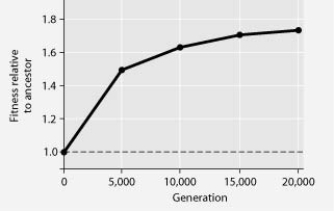Multiple Choice
The following question refers to the figure.
In this eight-year experiment, 12 populations of E. coli, each begun from a single cell, were grown in low-glucose conditions for 20,000 generations. Each culture was introduced to fresh growth medium every 24 hours. Occasionally, samples were removed from the populations, and their fitness in low-glucose conditions was tested against that of members sampled from the ancestral (common ancestor) E. coli population.
Compare the bacteria in the figure above in generation 1 and generation 20,000. The bacteria in generation 1 have a greater ________.
A) efficiency at exporting glucose from the cell to the environment
B) ability to survive on simple sugars, other than glucose
C) ability to synthesize glucose from amino acid precursors
D) reliance on glycolytic enzymes
Correct Answer:

Verified
Correct Answer:
Verified
Q58: Chloramphenicol is an antibiotic that targets prokaryotic
Q59: A hypothetical bacterium swims among human intestinal
Q60: Compared to eukaryotes, prokaryotes are _.<br>A) less
Q61: Leaf-cutter ants harvest plant leaves and bring
Q62: Genetic variation in bacterial populations cannot result
Q64: Use the following information and graph to
Q65: The following table depicts characteristics of five
Q66: The following question refers to the figure.<br>In
Q67: When a virus infects a bacterial cell,
Q68: Broad-spectrum antibiotics inhibit the growth of most